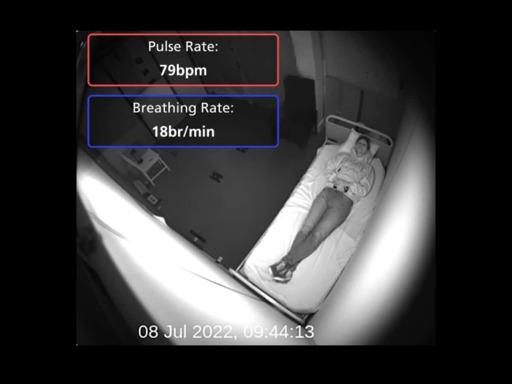Currently, at least 20 different NHS trusts are using a technology called ‘Oxevision’ to monitor patients on their mental health inpatient wards. Oxevision uses a camera and an infrared sensor to take vital sign readings and observe patients remotely.
Oxehealth, the company that created Oxevision, recently rebranded itself as ‘LIO’. It describes itself as being:
passionate about making mental health care safe, supportive and empowering for everyone.
Campaign group Stop Oxevision has called on NHS England to halt the use of Oxevision, pending an independant review into the risks and legality of the new technology. The National Survivor User Network (NSUN) is also supporting the campaign.
Stop Oxevision’s website states that:
Stop Oxevision is a campaign to highlight the use of Oxevision, a patient monitoring system consisting of an infrared sensor and camera, which can be used to take vital signs and observe patients remotely. Currently, increasing numbers of psychiatric hospitals in England use Oxevision, in all patient bedrooms, thus enforcing blanket, 24-hour surveillance without ongoing informed consent and individualised risk assessments.
What is Oxevision?
According to NHS guidelines, any patient admitted to a mental health inpatient facility has to be observed at least once every hour. That applies 24 hours a day, seven days a week.
The trusts using Oxevision reason that it can act as a replacement for in-person observations by staff members. The camera-sensor system can take video, and also monitors vital signs like pulse and breathing rate.
Oxford Health NHS Foundation’s patient-facing website explains that:
The system camera-sensors enables staff to see if you are in your bedroom and your location in your bedroom, to check you are safe and to measure your breathing rate and pulse without the need to enter your room and disturb you at night when you are asleep.
It notifies staff when you may need help or assistance, specifically, if you have been in the bathroom a long time, if someone else has entered your room while you are there, or when you are stood or sitting close to the main door and have been there a long time, or if you have left your room at night so that they can come to check on you.
Stop Oxevision
Stop Oxevision has written an open letter laying out its critique of Oxevision. It focuses on patients’ experiences of the technology being used in their care, and the potential legal and ethical pitfalls of its use. The letter acknowledges the draws of the technology, but is stark in its warnings:
While balancing a patient’s privacy and dignity with their safety is undoubtedly a challenge, surveillance is a restrictive practice and its use demands serious scrutiny. The use of blanket surveillance in this instance risks retraumatising patients who may have experienced trauma related to surveillance, compromises patient privacy and lacks clarity in relation to the use of footage and technology. Oxevision must not be used in place of sufficient staffing to benefit staff rather than to improve patient care, and consent needs to be specific, individual, informed and ongoing.
The comprehensive, referenced critique focuses on six key areas:
Surveillance as a restrictive practice.Patient consent.Impacts on privacy and dignity.Data protection concerns.Technology as a response to poor staffing/practices.The failure to scrutinise healthcare innovations.
Invasive, harmful and ethically fraught
The letter highlighted that both the Restraint Reduction Network and The British Institution of Human Rights consider surveillance to be a form of restrictive practice. Because Oxevision is installed in all patient bedrooms, it doesn’t leave space for individualised care planning or the consideration of less-restrictive options.
It’s deeply unclear how different NHS trusts gain patient consent to use Oxevision, or even if they seek consent at all. Patients who’ve had experience on wards which use Oxevision have stated that it’s used as standard procedure without their consent. Even when they’re requested that Oxevision isn’t used, the facilities simply continued to use it regardless.
24-hour surveillance is obviously a massive compromise to a patient’s privacy. Stop Oxevision used the example of a patient being caught in a state of undress, or even whilst they’re masturbating. Normally, a staff member would knock before entering. This let’s a patient would know that they’re about to be seen and react accordingly. However, the use of Oxevision means that a patient would never know if they’re being observed or not. The letter states that:
there are no controls in place to prevent staff abusing these systems and using Oxevision devices to view video images of patients when undressing.
Worse still, this video footage can be clipped and seen by Oxehealth staff, to monitor how the equipment is working. There’s very little clarity about how long this footage can be stored, or how it might be used in legal investigations regarding assault or patient death.
Money first, patients last
Reviews of Oxevision have praised the possibility that it can save money through reducing need for additional staff. However, this shows that healthcare services are using the technology to benefit staff, rather than the patients themselves. The company’s website also claims that it can help prevent staff from falsifying observation records. Or, to put this another way, in reaction to staff members mistreating the people in their care, privacy and dignity is simply being taken away from the patients.
Finally, Stop Oxevision criticised the fact that NHS Innovation Accelerator awarded public funds for the development of the tech. This represents a failure to perform due diligence regarding the implications and risks of new technologies and models of care, prior to endorsing them.
Stop Oxevision’s open letter can be found here: https://www.nsun.org.uk/news/open-letter-on-the-use-of-oxevision-in-inpatient-settings/
You can also sign their petition here:https://www.change.org/p/stop-the-rollout-of-oxevision-and-other-invasive-surveillance-in-psychiatric-hospitals
Featured image via the Canary
From Canary via this RSS feed


